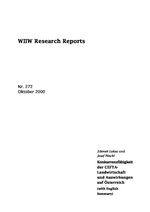Konkurrenzfähigkeit der CEFTA-Landwirtschaft und Auswirkungen auf Österreich (with English Summary)
Zdenek Lukas and Josef Pöschl
wiiw Research Report No. 272, October 2000
169 pages including 50 Tables, 25 Figures and 6 Maps
English Summary (full report in German language)
In general, the competitiveness of an individual enterprise is a matter of its ability to maintain or increase its market share over the longer term. Expressed in different terms, competitiveness is an enterprise's capacity to remain profitable under given market conditions. The same holds true for agriculture. The factors governing the survival of an agricultural enterprise are not only the supply of fixed inputs, the productivity of the inputs applied and the input prices, but also government subsidies and taxes. The prime decisive factor, however, is the demand for the agro-food products. Apart from the manner and extent of market regulation, a major determinant whether a farm can hold its own in the face of foreign competition on foreign and domestic markets is the exchange rate which, in turn, is governed by a series of non-agricultural factors. Compared to the European Union, agricultural production in the CEFTA countries features low average costs and low output prices. This has not been achieved by virtue of high standards of technology or management, but is attributable to exchange rates. With exchange rates working in their favour, agricultural enterprises in the CEFTA countries have been able to live with a relatively low level of subsidies. Discussions on competitiveness thus tend to focus on cost-related competitiveness. Where the CEFTA countries are concerned, this concentration on costs is particularly marked. However, this might well be a lopsided approach. The decisive issue is market power: competitiveness in markets.
In economic terms, the first half of the 1990s was the most difficult phase for the CEFTA countries. Yet even in more recent years they have not been immune to setbacks as evidenced primarily by Romania. Measured in terms of real GDP growth, the economies of Poland and Hungary experienced a pronounced upswing. Economic growth in Slovenia was somewhat slower, yet constant and very balanced. With the government taking steps to set the country's economy on a firmer footing, Slovakia had to accept a slowdown in growth. Over the past few months, however, all CEFTA countries have registered an improvement in their economies. The boom in Western Europe has spread to the CEFTA countries, most of whose economic structures have improved to such an extent that the openings they offer can also be used to good effect.
There are several reasons for the financial difficulties that farmers are yet facing. Over the past ten years, domestic and foreign markets, or shares therein, have been lost; furthermore, agricultural subsidies have been slashed, particularly in the early years of transformation, and given the dramatic rise in input prices, cost pressures have increased, outstripping the rise in output prices. In some CEFTA countries, farms are deeply in debt. In Slovakia and the Czech Republic numerous enterprises have accumulated claims outstanding and thus find themselves unable to service their own debts in an orderly manner.
At present, competitiveness in CEFTA agriculture is low. Most enterprises have not been modernized and the whole sector is fraught with structural shortcomings. In addition, for the farmers in the EU-15 and thus the farmers in Austria as well, applying the CAP regulations from the very first day of EU membership will reduce the threat of ruinous competition from the new member countries in the years to come.
Keywords: CEFTA countries, agriculture, competitiveness
JEL classification: Q11, Q13, Q17, P31
Countries covered: Austria, Czechia, Hungary, Poland, Romania, Slovakia, Slovenia, SEE, Visegrad countries
Research Areas: International Trade, Competitiveness and FDI, Sectoral studies
